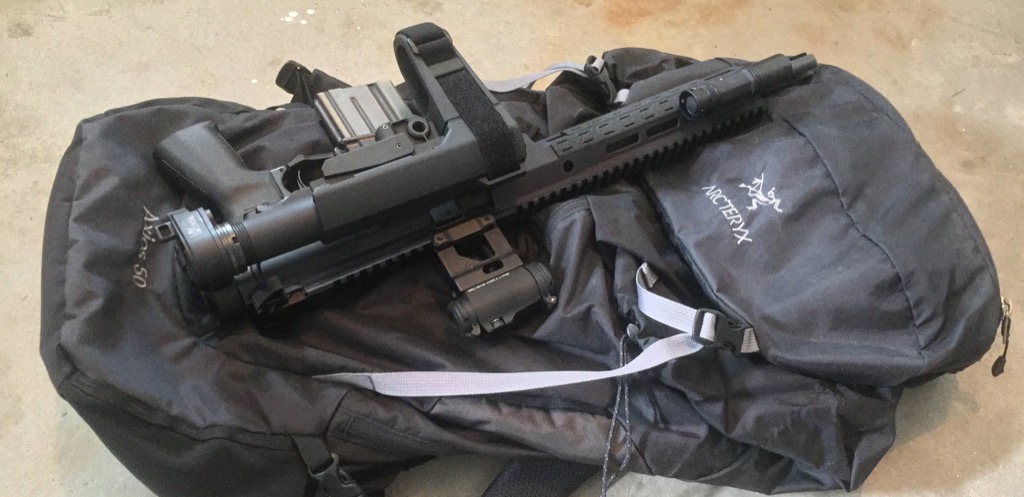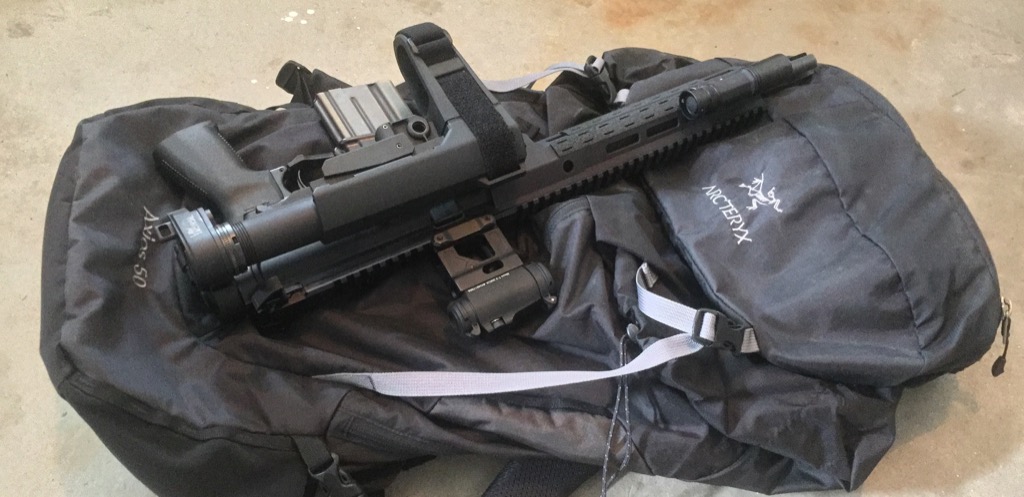Personal Defense Weapon (PDW) Bag Guns, by Joe H.


Personal defense weapons (PDWs) or “bag guns” have seen a recent surge in popularity due to concerns over the COVID-19 quarantine and urban riots. This has come just at the availability of more attractive PDW options is expanding. For the sake of this discussion, a PDW will be defined as a compact detachable magazine-fed semiautomatic firearm that can be shouldered. Such weapons are desirable as they can be discreetly transported and have greater firepower than conventional handguns. PDWs have been used by military and security details for these reasons. They are also included in pilot survival kits. Security details employ PDWs as they are more discreet and easy to maneuver in tight spaces. These features also make for an attractive bugout weapon, sine one can be carried and more easily accessed in a car. Some folks have chosen them home defense weapons.
History
The Uzi and MP5 are famous PDWs that have been used for years by militaries and security details around the world, generally in fully automatic. Both are chambered in 9mm and have several configurations, including those with collapsible stocks and different barrel lengths. There is even a PDW-designated MP5 that can be fired from within a suitcase. While both of these weapons continue to enjoy reasonable popularity, a number of new options have emerged.
Rifle Caliber PDW
Short barreled variants of combat carbines have seen wider use, as they provide the ballistics of a rifle caliber in a smaller package. Barrel length is limited by reliability and decreases in velocity. A popular example is the MK18 10.3 inch barreled M16 variant. It is commonly considered the shortest reliable barrel length for a direct impingement 5.56 mm AR-15-type rifle.
Pistol Caliber PDW
Manufacturers have been producing pistol caliber PDWs to compete with the Uzi and MP5. Some notable manufacturers included B&T, Sig, and CZ. Besides differences in actions, one major fundamental differences in the designs is the magazine location. Some utilize magazines that are fed into the pistol grip like the Uzi while others have magazine wells forward of the grip like the MP5. The former generally results in a shorter weapon while the latter generally allows for faster magazine changes. A recent trend is to have weapons that utilize popular service pistol magazines, most notably Glock double-stack 9mm magazines.
A Pistol Chassis?
A number of pistol chassis technologies have been released in the past ten years. These systems lock onto a popular service pistol’s accessory rail and allow them to be shouldered. This extra point of contact aids in a higher hit probability for most shooters. The chassis also allows for more accessories such as optics, lights, and lasers to be mounted. One attribute of a chassis system is that the chassis’ themselves are not considered firearms, under Federal law.
AR Folding Stocks
Folding stocks shorten the stored length of a PDW and aren’t new. Many piston-driven guns such as the AK-47 do not use a buffer and utilize relatively simple folding systems. AR-15-type weapons use a buffer system that does not allow the use of these types of folding stocks. The relatively recent Law Tactical folding stock secures the bolt carrier when folded and uses an extension to engage the buffer when closed. The Law Tactical system has been adopted by the FBI for use by its Hostage Rescue Team (HRT).
Pistol Arm Braces
The popularity of ATF-approved pistol arm braces have certainly contributed to the interest in PDWs as they provide more ways of firing firearms such as AR-15 pistols. The pistol designation also allows these weapons to be legally transported while loaded in many places where rifles cannot be. These also avoid the paperwork necessary for acquiring a short-barreled rifle, under Federal law. The issue of shouldering a braced pistol has been a point of contention will be left for the user to investigate for themselves.
.300 Blackout
The .300 Blackout (300 BLK), also known as .300 AAC is a 7.62 mm cartridge designated by Advanced Armament Corporation (AAC) that was designed for PDW use. Both supersonic and subsonic loadings are available, with the latter being relatively easy to suppress. The cartridge can be fed from a STANAG (AR) magazine and in AR-15 configuration can share all parts other than the barrel. 300 BLK has proven reliability in shorter barrel lengths than comparable 5.56 systems as well as improved terminal ballistics. It is a lower velocity caliber than 5.56 mm and thus has a shorter effective range, generally around 300 meters.
Specialty Caliber Weapons
Some specialty calibers have been developed specifically for PDW use with similar goals and claims. They tend to be smaller calibers that allow for high capacity but still reasonably sized magazines. These also tend to be higher velocity, targeting rifle caliber terminal ballistics. Examples of these calibers include the 6X35 mm (KAC), 4.6X30 mm (HK), and the 5.7X28 mm (FN). The first two are generally not available to civilians while the 5.7 mm is. The associated PDW that is available to the general public is the PS90 that uses a unique top-loading magazine. To be truly usable as a PDW, a shorter barrel would be preferred.
Intended Use
Your intended use should be considered before selecting a PDW. This can be a purely recreational range toy or a serious weapon with a defined purpose. The use will guide the selection of a PDW. Someone who is looking for a weapon meant to bring along for road trips may select a different weapon than someone who may need to employ a weapon for executive protection.
Size
The compact nature of the PDW is one of its primary attributes. It is important to consider the size of any candidate and its trade-offs. Smaller weapons are more discreet and easy to carry but generally give up effectiveness due to caliber and/or barrel length. Size will dictate how the weapon can be carried.
Can it Fire When Folded?
Different PDWs will allow for firing in different conditions, most notably while folded. Direct impingement AR-15-type weapons generally (see Law Tactical) generally cannot be fired while folded while many gas piston operated weapons can. Note that Law Tactical will be releasing a special bolt carrier that will allow for a weapon to be fired while folded.
Storage/Access
How the user intends to store and be able to access the weapon should be considered when selecting a weapon. Some systems like some Glock chassis systems do not have traditional safety levers. Shoulder bags allow for quicker access than a backpack but are generally smaller. One of the main purposes of a bag is concealment and a number of companies have made attractive bags for carrying these weapons.
Other popular options include bookbags, hiking backpacks, instrument cases (such as for trumpets), and tennis racquet cases. The user should consider how discreet the various options are for their lifestyle and use. Car carry is another popular option with its advantages and risks. The risk of vehicle theft should be taken into account when considering this option. After selecting a system, the user should practice accessing the weapon in its carry condition and making it ready to fire. It is up to the user or their respective organization to decide on their standard operating procedure and carry condition.
Caliber
Caliber selection is one of the critical decisions in selecting a PDW. One should probably first consider the maximum engagement distance the weapon in which the weapon may be employed. Rifle calibers will have much longer effective range than pistol calibers. Whether or not magnified optics will be attached will also dictate true effective range, noting that positive target identification is crucial. The first component of effective range is the ability to make reliable hits to an acceptable standard. The second is whether those hits will effectively stop a threat. Ammunition type will play a role in both of these but caliber is a significant factor. Availability of ammunition in the selected caliber that meet the criteria of the user is critical. An acceptable sound level is important to some users. Shorter barrels will be louder than longer ones and rifle calibers are louder than pistol calibers. Availability of subsonic ammunition and sound-safe suppressors may factor into caliber selection. It is noteworthy that specialty calibers may be more difficult to source than popular ones like 9mm or 5.56 mm. The ability to reload may help with this. And ammunition price is always a consideration, as specialty calibers tend to be more expensive than common ones.
Commonality
Commonality of parts, magazines, and calibers can be a factor when deciding on a PDW. Shorter versions of carbines that a user already owns would have the greatest amount of commonality. 300 BLK AR-style PDW’s magazines, bolt carrier groups, receivers, and accessories that are interchangeable with 5.56 systems. Pistol caliber PDWs that use Glock double stack magazines would allow users to carry magazines that are interchangeable with a Glock pistol. All of these parts are considered commonly available.
Accessories
Accessories should be considered when selecting a PDW. Common accessories for weapon systems include lights, slings, and optics. The intended role of the PDW will dictate which accessories will be needed. PDWs smaller size may require smaller or specialized accessories. These should also not interfere with accessing the weapon.
Legal Issues
Gun laws differ between states and even cities. Some areas have laws pertaining to legal storage of unattended firearms. The National Firearms Act (NFA) governs the acquisition and use of short-barreled rifles. Take note that adding a vertical foregrip is not legal on most arm-barced pistols. Users should learn the laws of any area they may plan to bring their prospective PDW before making decisions about what weapons they may bring and how they carry them.
The convenience and effectiveness of PDWs make them attractive to many gun owners. If one is considering purchasing a PDW, they should consider their motivations and then review the many options and considerations provided here, including those pertaining to where and how they plan to carry and potentially employ the weapon. With that said, PDWs are very cool and highly recommended.
